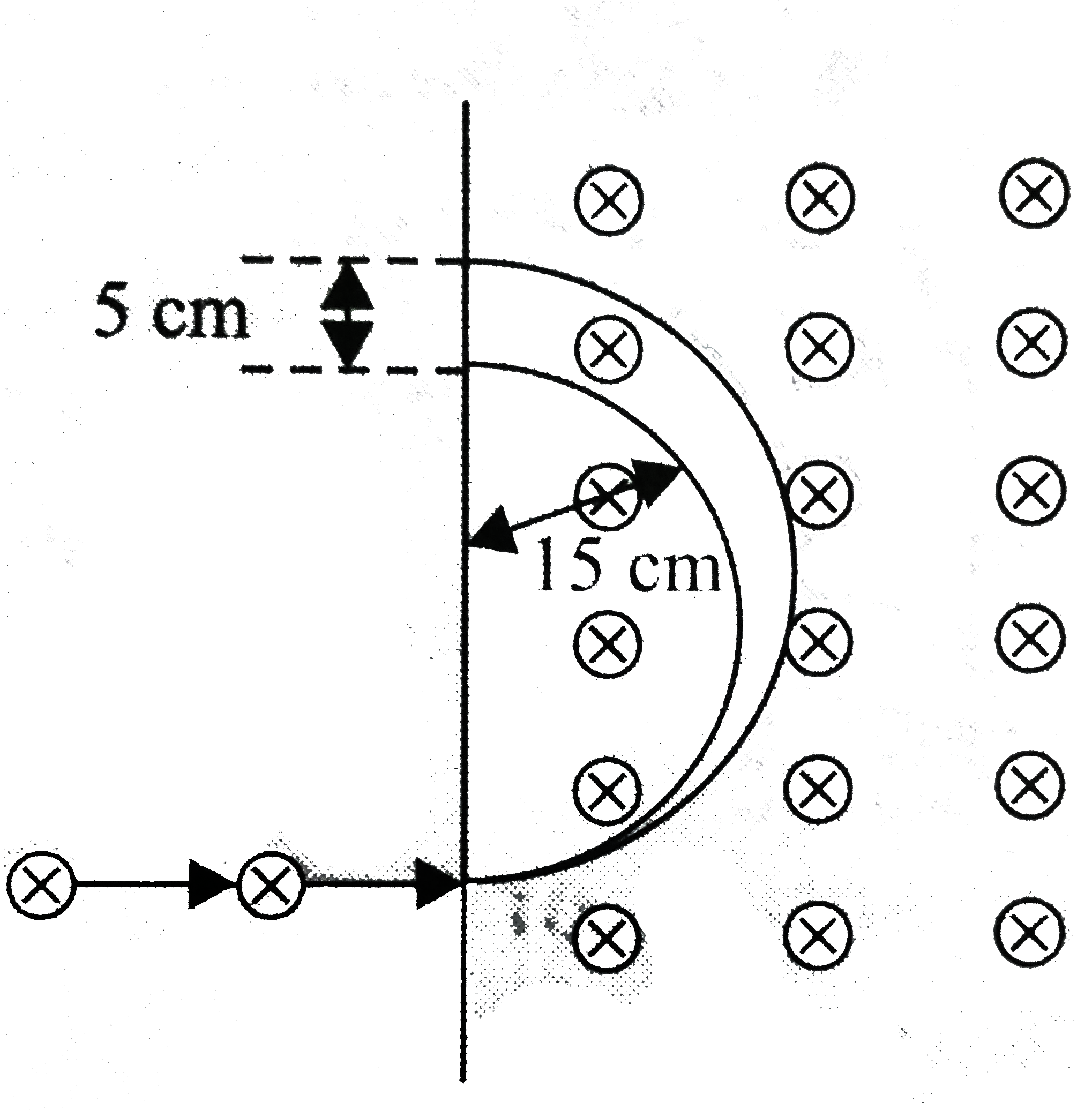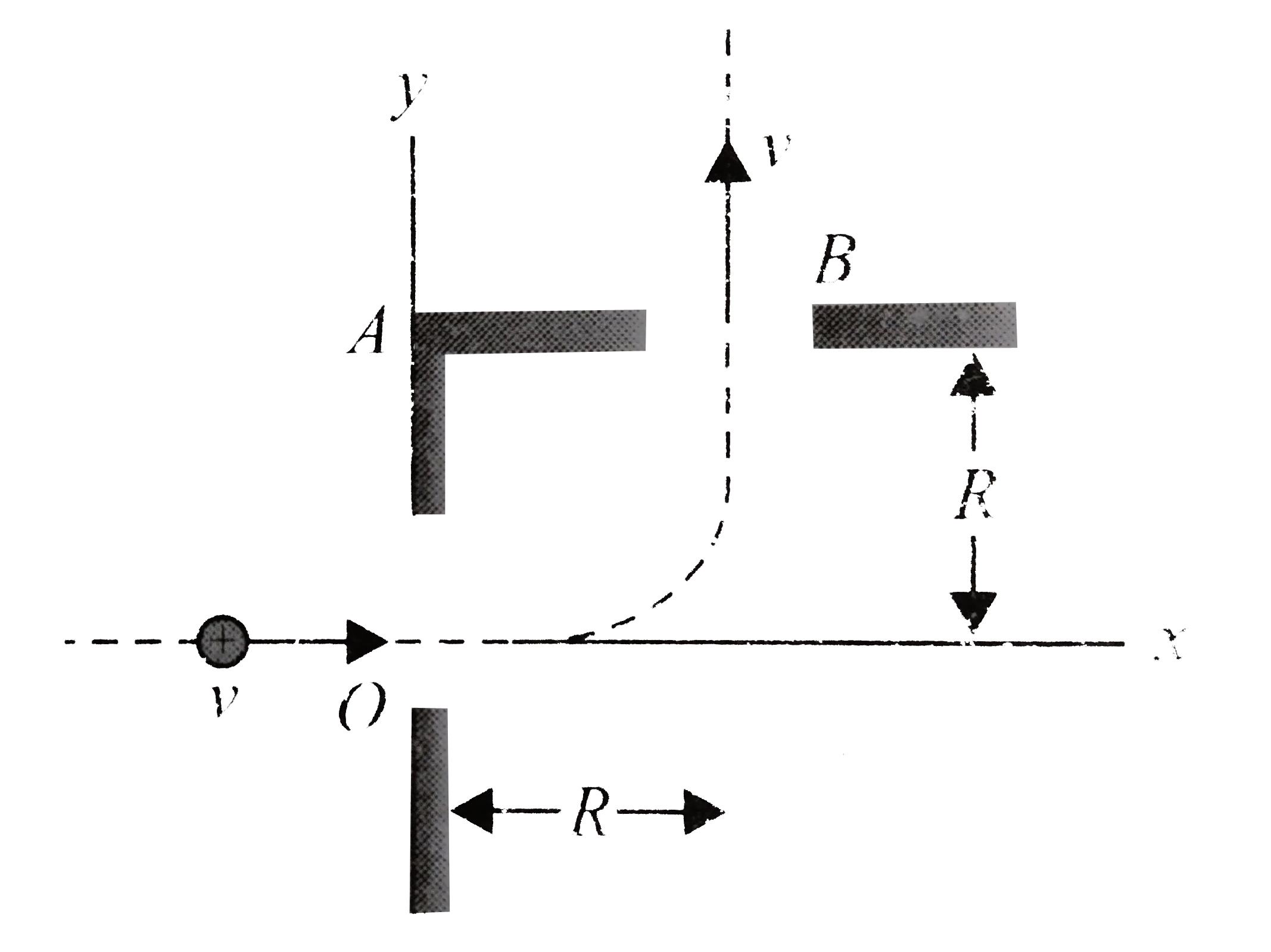A beam of singly ionized atoms of carbon (each charge +e) all have the same speed enters a mass spectrometer, as shown in Fig. The ions strike the photographic plate in two different locations 5 cm apart. The .12C6 isotope traces a path of smaller radius, 15.0cm. What is the atomic mass number of other isotope ?
 .
.
Let R1 be the radius of trajectory of the isotop .12C6 and R2 that of the unknown isotope. The trajectory of the unknown isotope has a greater radius, and so the mass of the unknown isotop is greater than that of the .12C6 isotop. From the figure provided in the question,
d=2r=2mvqB⇒m∝d
mA2mA1=d2d1=A212=3530⇒A2=14
Thus, the unknown isotope is .14C6
Topper's Solved these Questions
- BOOK - CENGAGE PHYSICS ENGLISHCHAPTER - MAGNETIC FIELD AND MAGNETIC FORCESEXERCISE - Exercise 1.213videos
MAGNETIC FIELD AND MAGNETIC FORCES
- BOOK - CENGAGE PHYSICS ENGLISHCHAPTER - MAGNETIC FIELD AND MAGNETIC FORCESEXERCISE - Exercise1.314videos
MAGNETIC FIELD AND MAGNETIC FORCES
- BOOK - CENGAGE PHYSICS ENGLISHCHAPTER - MAGNETIC FIELD AND MAGNETIC FORCESEXERCISE - Solved Example25videos
MAGNETIC FIELD AND MAGNETIC FORCES
- BOOK - CENGAGE PHYSICS ENGLISHCHAPTER - INDUCTANCEEXERCISE - Concept Based8videos
INDUCTANCE
- BOOK - CENGAGE PHYSICS ENGLISHCHAPTER - MISCELLANEOUS VOLUME 3EXERCISE - True and False3videos
MISCELLANEOUS VOLUME 3
Similar Questions
The existence of negatively charged particle in an atom was shown by J.J. Thomson as a result of the studies of the passage of electricity through gases at extremely low pressure known as discharge tube experiments. When a high voltage of the order of 10,000 volts or more was impressed across the electrodes, some sort of invisible rays moved from the negative electrode to the positive electrode these rays are called as cathode rays.

Cathode rays travel in straight path in absence of electrical and magnetic field . Cathode rays consist of material part and charged particles? Cathode rays produce X-rays and light is emitted when they strike on ZnS screen. Cathode rays penetrate through thin sheets of aluminium and other metals . They affect the photogenic plate and passes heating effect when they strike on metal foil. The raito of charge to mass i.e charge/mass is same for all the cathode rays irrespective of the gas used in the tube.
The existence of positively charged particle in an atom was shown be E. Goldstein. He repeated the same discharge tube experiments by using a perforated cathode. It was observed that when a high potential difference was applied between the electrodes, not only cathode rays were produced but also a new type of rays were produced simultaneoulsy from anode moving towards cathode and passes through the holes or canal of the cathode. These termed as canal rays or anode rays.
These rays travel in straight lines and consists of positively charged particles. These rays have kinetic energy and produces heating effect also. The e/m ratio of these rays is smaller than that of electrons. Unlike cathode rays, their e/m value is dependent upon the nature of the gas taken in the tube. These rays produced flashes of light on ZnS screen and can pass throughs thin metal foils. They can produce physical and chemical changes and are capable to produce ionisation in gases.
For cathode rays the value of e/m:View SolutionThe existence of negatively charged particle in an atom was shown by J.J. Thomson as a result of the studies of the passage of electricity through gases at extremely low pressure known as discharge tube experiments. When a high voltage of the order of 10,000 volts or more was impressed across the electrodes, some sort of invisible rays moved from the negative electrode to the positive electrode these rays are called as cathode rays.

Cathode rays travel in straight path in absence of electrical and magnetic field . Cathode rays consist of material part and charged particles? Cathode rays produce X-rays and light is emitted when they strike on ZnS screen. Cathode rays penetrate through thin sheets of aluminium and other metals . They affect the photogenic plate and passes heating effect when they strike on metal foil. The raito of charge to mass i.e charge/mass is same for all the cathode rays irrespective of the gas used in the tube.
The existence of positively charged particle in an atom was shown be E. Goldstein. He repeated the same discharge tube experiments by using a perforated cathode. It was observed that when a high potential difference was applied between the electrodes, not only cathode rays were produced but also a new type of rays were produced simultaneoulsy from anode moving towards cathode and passes through the holes or canal of the cathode. These termed as canal rays or anode rays.
These rays travel in straight lines and consists of positively charged particles. These rays have kinetic energy and produces heating effect also. The e/m ratio of these rays is smaller than that of electrons. Unlike cathode rays, their e/m value is dependent upon the nature of the gas taken in the tube. These rays produced flashes of light on ZnS screen and can pass throughs thin metal foils. They can produce physical and chemical changes and are capable to produce ionisation in gases.
Which is not true with respect to cathode rays?View SolutionThe existence of negatively charged particle in an atom was shown by J.J. Thomson as a result of the studies of the passage of electricity through gases at extremely low pressure known as discharge tube experiments. When a high voltage of the order of 10,000 volts or more was impressed across the electrodes, some sort of invisible rays moved from the negative electrode to the positive electrode these rays are called as cathode rays.

Cathode rays travel in straight path in absence of electrical and magnetic field . Cathode rays consist of material part and charged particles? Cathode rays produce X-rays and light is emitted when they strike on ZnS screen. Cathode rays penetrate through thin sheets of aluminium and other metals . They affect the photogenic plate and passes heating effect when they strike on metal foil. The raito of charge to mass i.e charge/mass is same for all the cathode rays irrespective of the gas used in the tube.
The existence of positively charged particle in an atom was shown be E. Goldstein. He repeated the same discharge tube experiments by using a perforated cathode. It was observed that when a high potential difference was applied between the electrodes, not only cathode rays were produced but also a new type of rays were produced simultaneoulsy from anode moving towards cathode and passes through the holes or canal of the cathode. These termed as canal rays or anode rays.
These rays travel in straight lines and consists of positively charged particles. These rays have kinetic energy and produces heating effect also. The e/m ratio of these rays is smaller than that of electrons. Unlike cathode rays, their e/m value is dependent upon the nature of the gas taken in the tube. These rays produced flashes of light on ZnS screen and can pass throughs thin metal foils. They can produce physical and chemical changes and are capable to produce ionisation in gases.
Select the incorrect statement.View SolutionIn a helium dilution refrigerator .3Heand.4He are mixed in a special chamber to obtain extremely low temperature. A Bainbridge mass spectrometer is used to measure the ratio of the two isotopes
(a) If the spectrometer were used with 100 V cm−1 between the plates and a magnetic field of 0.2 T, what would be the speed of an ion that can pass through the velocity filter?
(b) If the velocity-filter exit slit were 1 mm wide, could this machine resolve the two isotopes ?View SolutionA researcher studying the properties of ions in the upper atmosphere wishes to construct an apparatus with the following charateristics: Using an electric field, a beam of ions, each having charge q, mass m , and initial velocity vˆi, is turned through an angle of 90∘ as each ion undergoes displacement Rˆi+Rˆj. The ions enter a chamber as shown in figure and leave through the exit port with the same speed they had when they entered the chamber. The electric field acting on the ions is to have constant magnitude.

If the field is produced by two flat plates and is uniform in direction, what value should the field have in this case?View SolutionHydrogen accounts for approximately 75% of the mass of the universe. Hydrogen serves as the nuclear fuel of our Sun and other stars, and these are mainly composed of hydrogen. On the earth, though hydrogen is rarely found in the uncombined state. Since the earth's gravity is too weak to hold such light molecules, nearly all the H2 originally present in the earth's atmosphere has been lost to space. In the earth's crust and oceans, hydrogen is found in water, petroleum, proteins, carbohydrates and other compounds and it is the ninth most abundant element on a mass basis. Hydrogen has three isotopes : hydrogen or protium (H), deuterium or heavy hydrogen (D or ), tritium (Tor). The physical properties of the three isotopes are different due to the difference in their masses, i.e. isotope effect. The chemical properties of the three isotopes are similar as they have the same electronic configuration. Reaction between hydrogen and oxygen is highly exothermic, and gas mixtures that contain as little as 4% by volume hydrogen in oxygen (or in air) are highly flammable and potentially explosive.
2H2(g)+O2(g),ΔHɵ=−485kJmol−1
As hydrogen is environmentally clean it is an enormously attractive fuel. 'Hydrogen economy' is an emerging field in which it is thought that our energy needs can be met by gaseous, liquid and solid hydrogen. As hydrogen is no a naturally occuring substance such as coal, oil or natural gas, energy must be exploaded to produce hydrogen before it can be used.
If an isotope of hydrogen has one neutron in its atom, its atomic number and atomic mass will respectively beView SolutionIn an experiment on two radioactive isotopes of an element (which do not decay into each other), their number of atoms ratio at a given instant was found to be 3. The rapidly decaying isotope has large mass and an activity of 1.0μCi initially. The half-lives of the two isotopes are known to be 12 hours and 16 hours. what would be the activity of each isotope and their number of atoms ration after two days?
View SolutionA bottle of red wine is thought to have been sealed about 5years ago. The wine containa a number of different kinds of atoms, incluing carbon, oxygen,and hydrogen. Each of these has a radioactive isotope. The radiaoctive isotope of carbon is the familiar .146C with a half-life of 5730years. The radioactive isotope of oxygen is. .158O and has a half-life of 122.2s. The radioactive isotope of hydrogen .31H and is called tritium, its half-life is 12.33years. The activity of each of these isotopes is known at the time the bottle was sealed. However, only one of the isotopes is useful for determining the age of the wine accurately. Which is it?
View SolutionTwo particles A and B having equal charges +6C, after being accelerated through the same potential differences, enter a region of uniform magnetic field and describe circular paths of radii 2cm and 3cm respectively. The ratio of mass of A to that of B is
View SolutionTwo particles A and B having equal charges +6C, after being accelerated through the same potential differences, enter a region of uniform magnetic field and describe circular paths of radii 2cm and 3cm respectively. The ratio of mass of A to that of B is
View Solution

